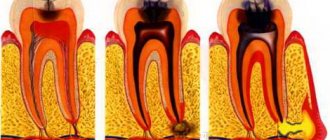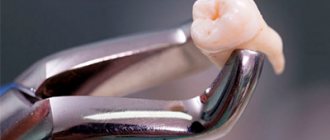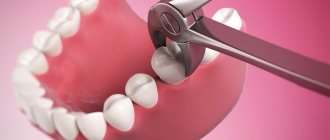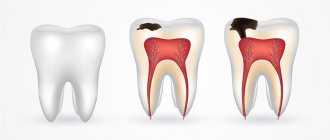Signs of a filling falling out soon
How can you tell if a filling has fallen out? This is quite simple - at the place of its installation there is no material with which the filling was made, and there is a hole. Therefore, it is better to prevent such a phenomenon and contact a specialist in advance, even before complete loss.
Determining that the filling does not stay in the tooth and will soon fall out is also quite simple. Gaps appear between the tooth surface and the filling material, which are almost invisible at first, but become larger over time. The material itself becomes loose. This is felt when you press the seal with your tongue. If such phenomena are observed, you should immediately consult a doctor so as not to be annoyed later that the filling has come out.
Either there is something wrong with the doctor, or with the teeth
While you are wondering what to do, there are a couple of simple recommendations. First of all, do your best to rest the tooth. Try not to bite or chew with this tooth. Pay close attention to hygiene, but do not overdo the brushing on the exposed area. Rinse your mouth as often as possible so that bacteria do not have a chance to settle in a new place.
For rinsing, ordinary warm boiled water will do, but even better if it is a decoction of chamomile or calendula. They provide an excellent bacteriostatic effect. And do not delay your visit to the dentist, otherwise you may develop serious diseases and lose a tooth.
Mouth rinse
Video - Why change the filling
Necessary actions if a filling falls out
It is important to know what to do if a filling falls out. It is advisable to immediately make an appointment with a dentist, but in some cases it is not possible to urgently visit a doctor. When a filling has come out of a tooth, you can do without it for a short time, but only for a certain time.
If treatment is delayed, the tooth may become infected, leading to acute pain and gradual destruction. It is important to visit a specialist in a timely manner, regardless of whether the filling is permanent or temporary.
But it is better to avoid such a situation and visit the dentist at the stage of loosening. Any gap or even minimal gap between the tooth and the filling is a place for bacteria to enter.
And if you don’t pay attention to such a problem in time, then you shouldn’t be surprised that the filling has fallen out between the teeth.
Most often, such troubles occur with molars. They experience a lot of stress and the filling material can be destroyed if you often eat solid foods. Fillings on the front tooth fall out much less frequently.
What to do?
Of course, you need to see a dentist. But the patient does not always have the opportunity to urgently leave work. In addition, many people believe that there is nothing wrong with a filling falling out and are in no hurry to visit the dentist.
When the doctor places a filling, he notifies the patient about what materials are used and for how long it is installed. It is important to remember this, because if the doctor used arsenic-based paste to kill the nerves, then one should not hesitate in case of material loss. This substance is poisonous! If it gets on the mucous membrane, it causes a burn, and if swallowed, it causes poisoning, gastrointestinal upset, and the development of an allergic reaction.
Therefore, if the patient notices a hole in the tooth, he needs to thoroughly rinse the oral cavity with a soda solution (dissolve 1 teaspoon of soda in 1 glass of warm boiled water and add a few drops of iodine). After this, you need to cover the hole with a sterile gauze swab and go to the doctor.
If the dentist filled the canals and installed a temporary filling, but it fell out, this is not so dangerous. After all, there is no toxic substance inside the tooth and infection will no longer penetrate into the canals. But you still need to visit a dentist to solve the problem. The doctor will conduct an examination and decide what to do - put a temporary filling again or replace it with a permanent one.
We recommend remembering the following algorithm of actions:
- If the filling falls out while eating, it is better to spit out the chewed food. After this, you need to rinse your mouth with an antiseptic (Chlorhexidine, Miramistin) or a soda solution. If you don't have this on hand, you can use mouthwash or clean water.
- You should not try to close the hole with chewing gum or other improvised means, or pick out the remnants of the filling material. There is a risk of damaging the mucous membrane or leaving a piece of the used “tool” in the hole, which will provoke the development of the inflammatory process. Do not try to insert a painkiller or antibiotic tablet into the hole. It won't help.
- Before eating, it is necessary to cover the damaged unit with a sterile gauze pad and minimize the load on this side of the jaw. Be sure to rinse your mouth thoroughly after every meal.
- If pain bothers you, you can take a non-steroidal anti-inflammatory drug, for example, Nurofen, Trialgin, Ketanov, etc. The recommended duration of taking these medications without medical supervision is no more than 3 days.
- As a result, in any case, you need to make an appointment with the dentist and have your tooth treated.
It should be remembered that you should not put off visiting a doctor until later. This is fraught with the development of an inflammatory process and may lead to the need to remove the unit.
Pain after a filling falls out and other unpleasant consequences
Simple recommendations for patients on what to do when a filling falls out and a tooth hurts:
- You need to rinse with a solution of baking soda and salt.
- You can take a painkiller, it could be Ketanov or Analgin.
- During the inflammatory process, the temperature may rise. It must be knocked down after exceeding 38.5° C. For this, antipyretics are used.
- If there is bleeding from a tooth, you should immediately consult a doctor. There can be many reasons for this phenomenon, and it will be possible to accurately determine the possible problem only after an appropriate examination.
You can find many tips on how to numb a tooth at home, but the most effective option is to rinse and take appropriate medications.
When a filling with arsenic falls out, you need to carefully remove the remaining medication with a cotton swab and rinse the tooth cavity with a soda solution.
Is it possible to close a hole in a tooth yourself?
The question often arises as to what can be used to seal a temporarily opened cavity if a filling falls out. People use a wide variety of materials for these purposes - from cotton wool to chewing gum, in general - everything that can be used to fill a hole at home. Under no circumstances should this be done. Before you tape a tooth, you should think about the consequences. The cavity will not be closed hermetically, which means food debris and bacteria will get into it.
Before you think about how to plug a tooth at home, it is worth considering that any material will create extremely favorable conditions for the proliferation of microbes and the occurrence of infection or inflammation. Therefore, the question of how to cover the tooth should not arise. To avoid the accumulation of food debris in the cavity, it should be rinsed regularly at least 6-7 times a day.
Question No. 7: is it possible to put the filling in place yourself?
The filling fell out. What else should you do before seeing a doctor? To protect the resulting cavity from bacteria and food, you can close it yourself using a piece of cotton wool or a bandage. However, such a protective barrier will have to be changed quite often. This should be done after every snack, tea or meal. Additionally, you need to rinse your mouth with antiseptics (for example, Miramistin), herbal decoctions (chamomile and sage are suitable), and a soda solution. But you shouldn’t think about making a homemade filling, or even more so gluing it. By doing this you can only aggravate the situation and cause tissue damage or infection.
Treatment process
People faced with such a problem are interested in how the tooth will be treated when the filling has fallen out. It all depends on individual characteristics, so it is worth considering the most common situations.
If the carious cavity is too large, it makes no sense to fill it again. The material will not hold and will fall out again after a short time. Therefore, the doctor will suggest alternative methods of eliminating the defect, most likely installing a crown.
If repeated caries occurs, pulpitis or other diseases develop, they must first be cured. The doctor prescribes and carries out all the necessary measures and, after complete recovery, places a new filling. If the filling material falls out of a pulpless tooth, re-filling is often also ineffective. In this case, the specialist will recommend installing a pin.
Methods for restoring the integrity of a tooth depend on its condition, so it is difficult to suggest a treatment plan without a preliminary examination.
Lost temporary filling
What to do when a temporary filling falls out? It is placed to fix the medicine in the tooth cavity and prevent the entry of saliva, food debris and microbes. Arsenic, which is poisonous, is used as a medicine. Therefore, if such a situation arises, a number of measures need to be taken:
- carefully examine the tooth cavity and determine whether the medicine remains there;
- if it remains, carefully remove it with a cotton swab;
- make a warm soda solution (at the rate of 1 teaspoon of soda per glass of water);
- rinse the tooth cavity thoroughly.
When the canals are sealed, the loss of a temporary filling does not cause significant discomfort, but leaving the tooth as is is prohibited. It can be destroyed under the influence of various factors. For a filling to fail, there must be significant reasons and only a specialist can eliminate them.
If a filling with arsenic falls out immediately after visiting a specialist, you need to make a second appointment as soon as possible and have it restored. If there are several days left until the next scheduled appointment, you don’t have to reschedule it and visit the doctor when it’s scheduled. Only a dentist can tell you how long you can walk without a filling, so it’s a good idea to call and get a consultation.
Loss of fillings in children
When a child’s filling falls out, you should not ignore the problem, even if the teeth are baby. Caries and other diseases can provoke severe pain and the development of an inflammatory process.
What to do if a temporary filling falls out of a baby tooth:
- Call your doctor, consult and make an appointment as soon as possible.
- Ensure that your child maintains good oral hygiene.
- Rinse your teeth regularly to remove food debris.
Important! Fillings on baby teeth fall out for various reasons, and only a specialist can determine what causes this phenomenon. So, in any case, you cannot do without a visit to the dentist.
Prevention
To prevent permanent (temporary) fillings from falling out, it is recommended to follow simple rules:
- visit the dentist at least once every six months, even when there are no symptoms of oral diseases;
- brush your teeth efficiently, use dental floss, and mouth rinses to minimize not only the risk of fillings falling out, but also the development of any dental pathologies;
- If possible, you should avoid hard “traumatic” food, chewing of which can cause the fillings to crumble and fall out;
- The daily menu should be enriched with foods with a high calcium content (in particular, milk and its derivatives).
It is important to remember that if a filling falls out in a child or pregnant woman, a visit to the doctor is also necessary. Baby teeth must be treated, and pregnancy is not a contraindication to dental procedures. If the patient seems that problems with fillings are associated with the incompetence of the dentist (especially if they have arisen more than once), there is no need to risk the health of your own teeth; it is better to turn to another specialist.
Filling falling out during pregnancy
When a temporary filling falls out during pregnancy, this is a reason to urgently consult a dentist. Many women worry that treatment may negatively affect the course of pregnancy. Women carrying a child are certainly at risk, but doctors are well aware of the acceptable limits of exposure. If necessary, the doctor will select the optimal method of intervention so as not to harm the body.
You need to treat your teeth anyway. Carious lesions are an ideal environment for the development of pathogens that can cause much more harm to a pregnant woman than the process of restoring a diseased tooth.
If a filling falls out at the end of pregnancy - in the 3rd trimester, the doctor may postpone treatment if serious intervention is necessary to restore the tooth. In most cases, the specialist will make do with minimal temporary treatment, and will carry out complex measures carried out under anesthesia after childbirth.
Destruction of the seal
Has the filling broken? This is evidence of its gradual destruction. This phenomenon can occur for various reasons. The main ones:
- Too much zeal when carrying out hygiene procedures. Frequent use of a hard brush can cause damage to the filling material or enamel.
- Large loads on the tooth. They occur when eating solid foods, seeds, nuts and the like.
- Poor quality filling material.
- Failure of a specialist to comply with the technological process.
What to do if a piece of the filling breaks off and your tooth hurts? This indicates that the material does not adhere tightly to the surface and a gap has arisen between the filling and the tooth. Pain is a consequence of the inflammatory process. If the pathology is not eliminated, it will develop and cause various diseases.
If a filling breaks on a dead tooth, a crown will have to be placed in any case. If a problem arises on a front tooth that is still alive, the doctor will suggest depulping it and then installing a crown as well.
How to be pregnant?
Girls who are planning a pregnancy make every effort to resolve dental issues before they find out the long-awaited news. But from the moment of conception, they are at the forefront of those who can lose their fillings. Against the background of hormonal imbalance and calcium deficiency, the structure and hardness of the tooth may change, which leads to the loss of the filling. In this situation, you should not wait for childbirth - go straight to the doctor, only he will be able to offer the right solution to your problem in order to save the tooth and not harm the fetus.
Pregnant woman at the dentist
You can save fillings:
- Caries under filling
- initially make a choice in favor of well-known clinics and doctors with recommendations;
- do not hesitate to discuss the choice of filling materials with your doctor. Ask him to justify his choice;
- Treat fillings with care and caution. Do not crash test them with food;
- Remember the importance of hygiene.
Having given advice, I can calmly say goodbye. Take care of your teeth and remember that the best friend in treatment is prevention, and there is no need to be afraid of the treatment itself. Subscribe and receive even more useful articles. Please contact us with any questions or comments via the comments and don’t forget to share the article!










